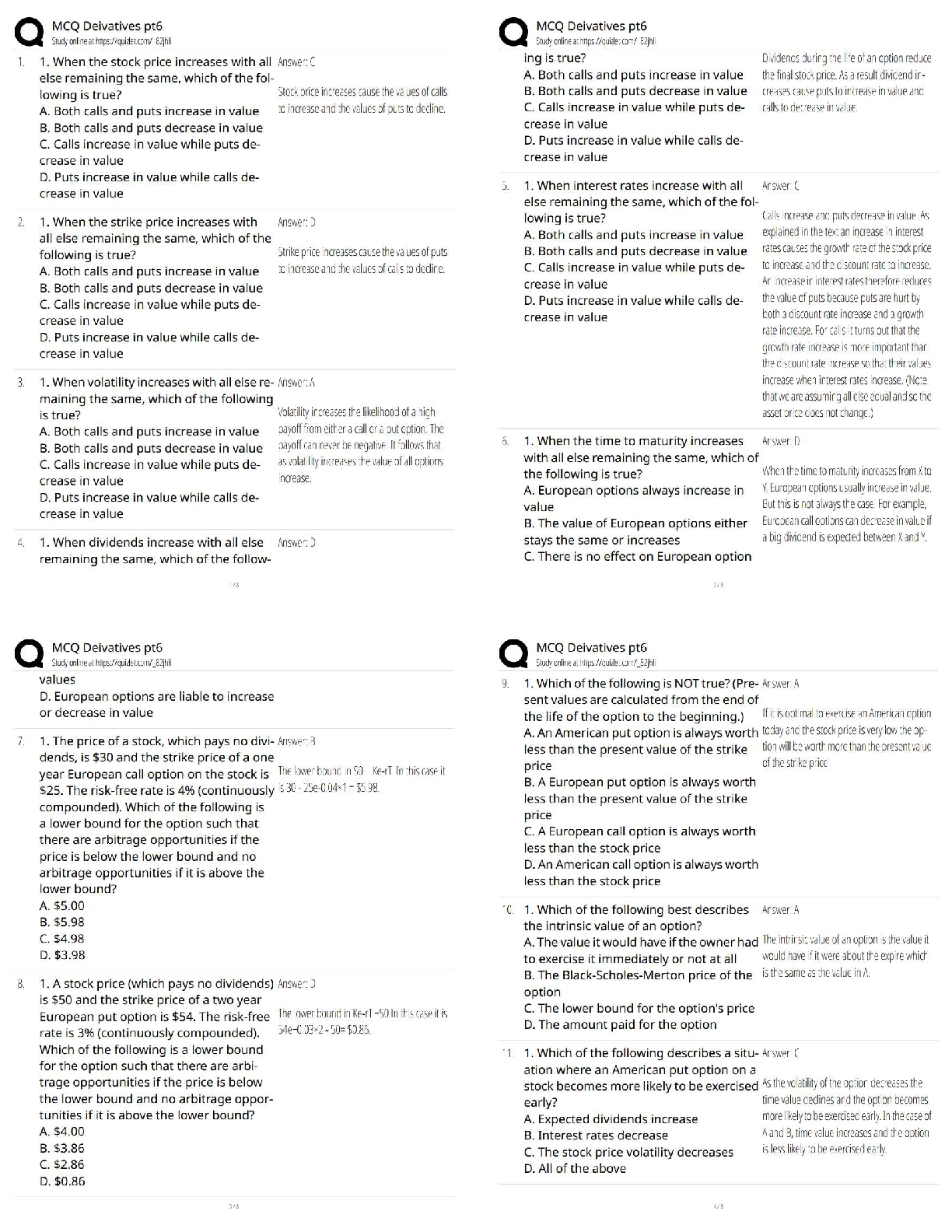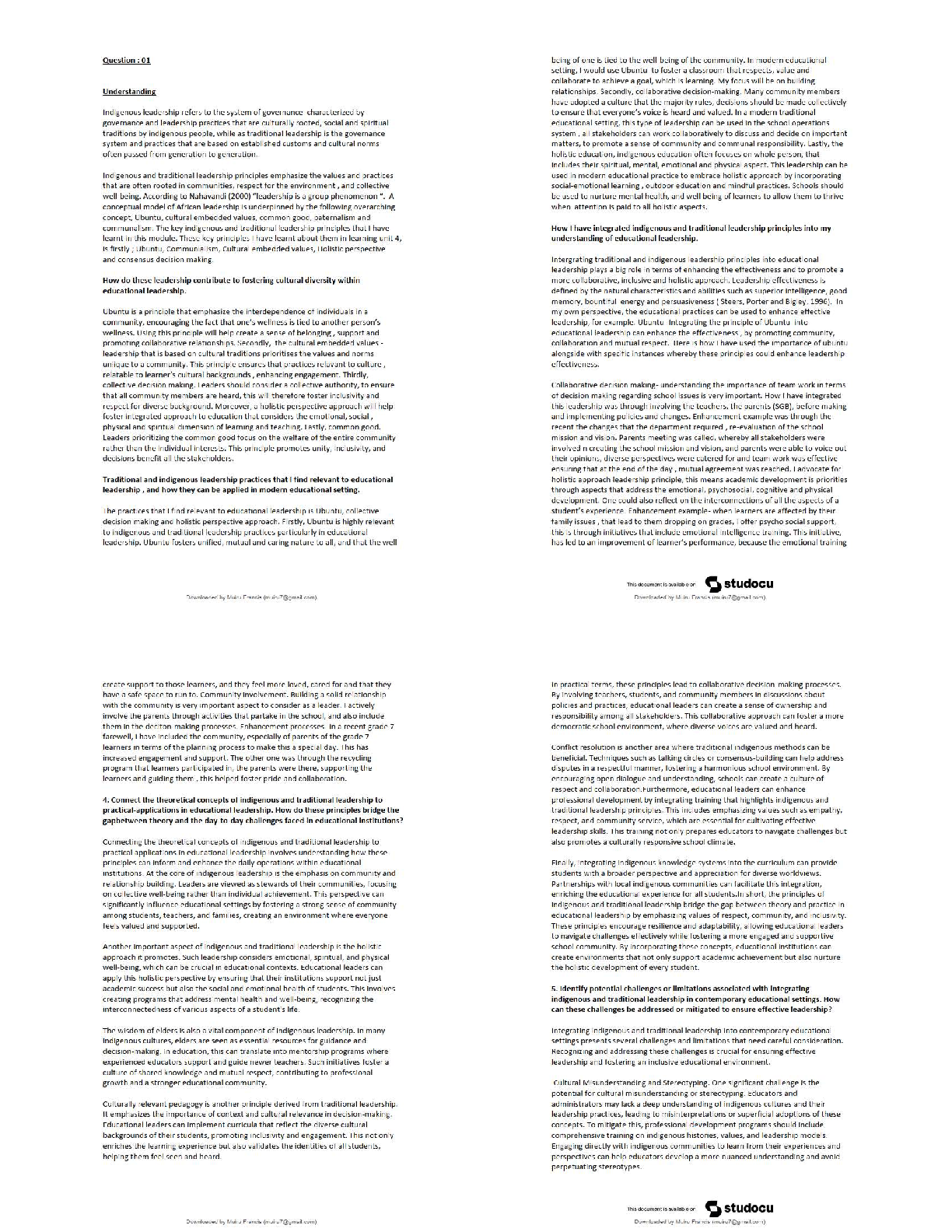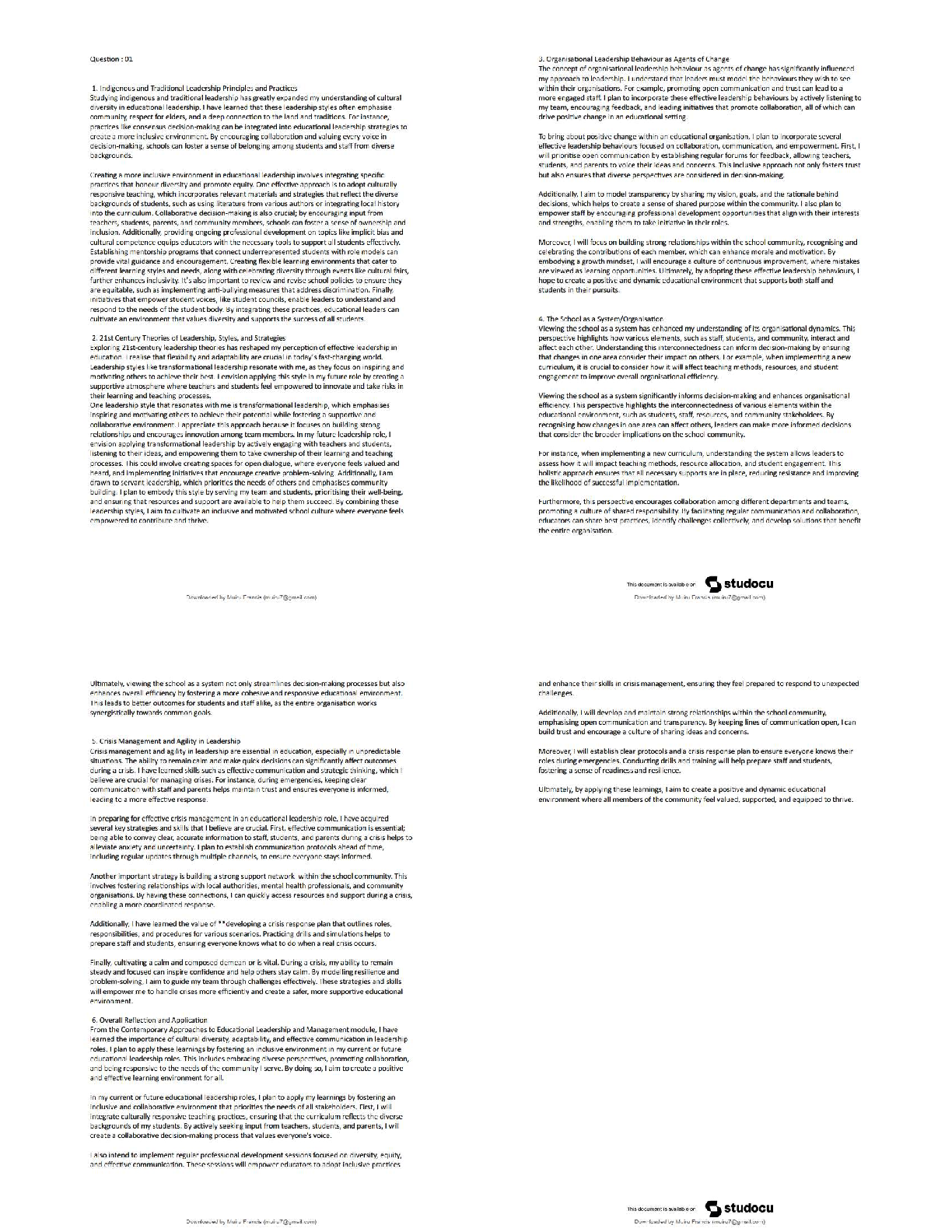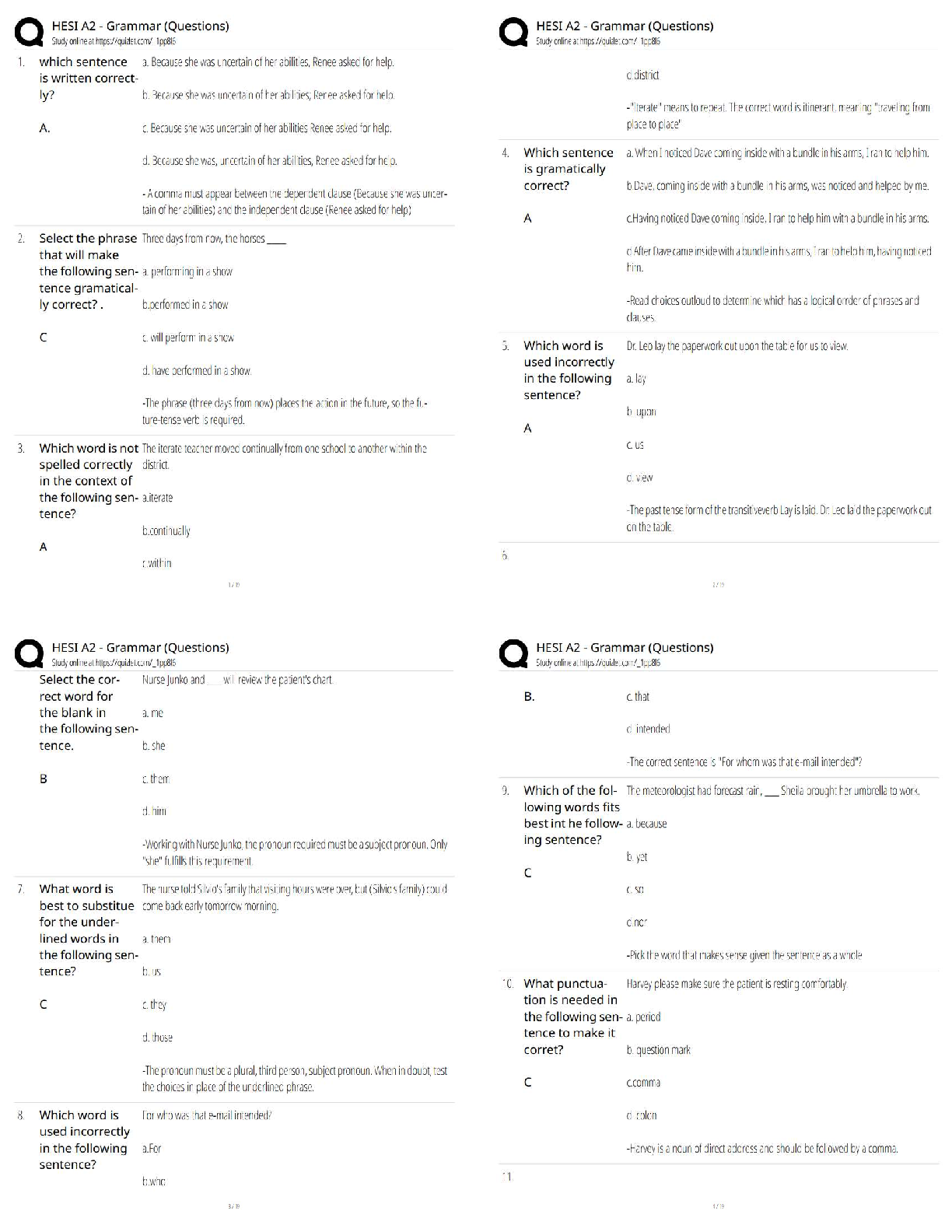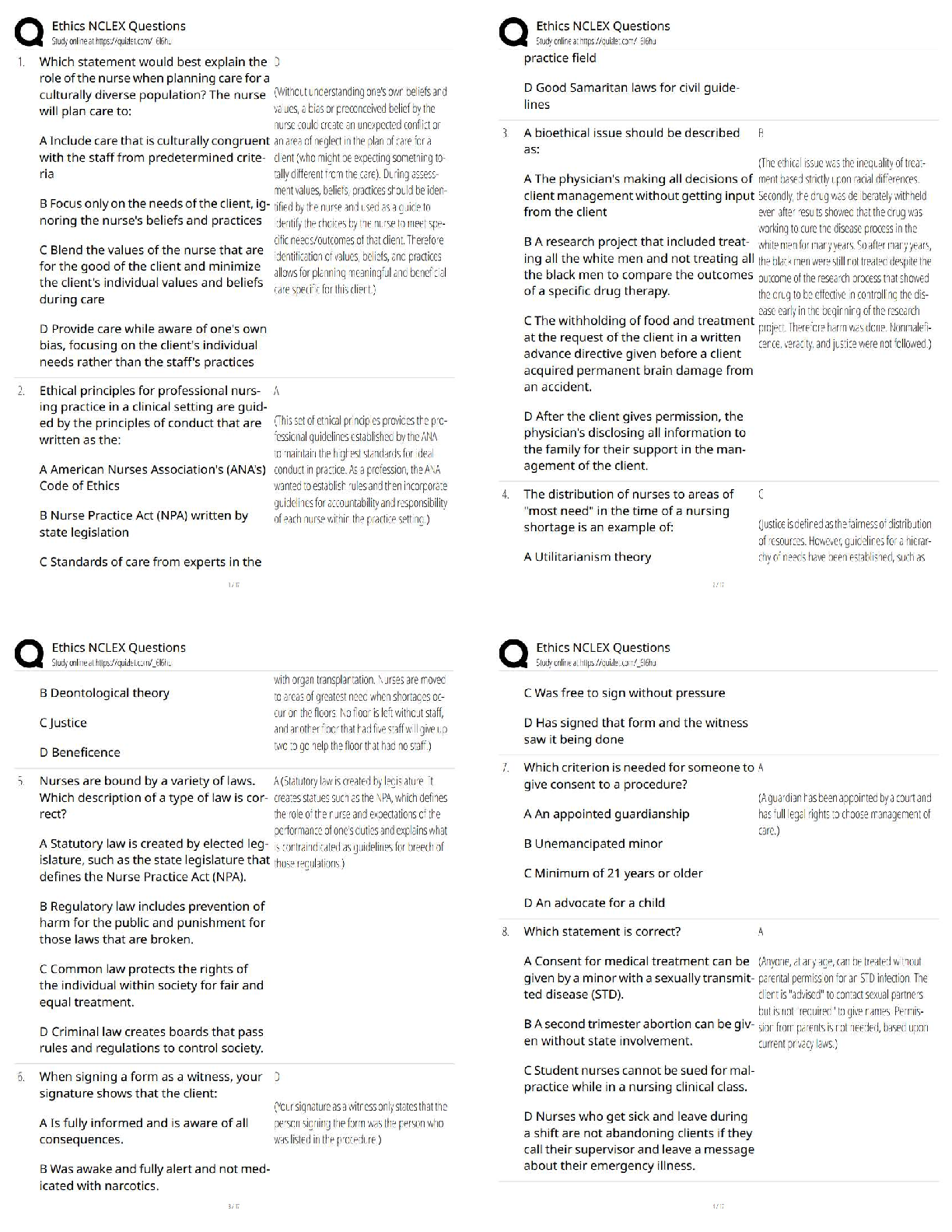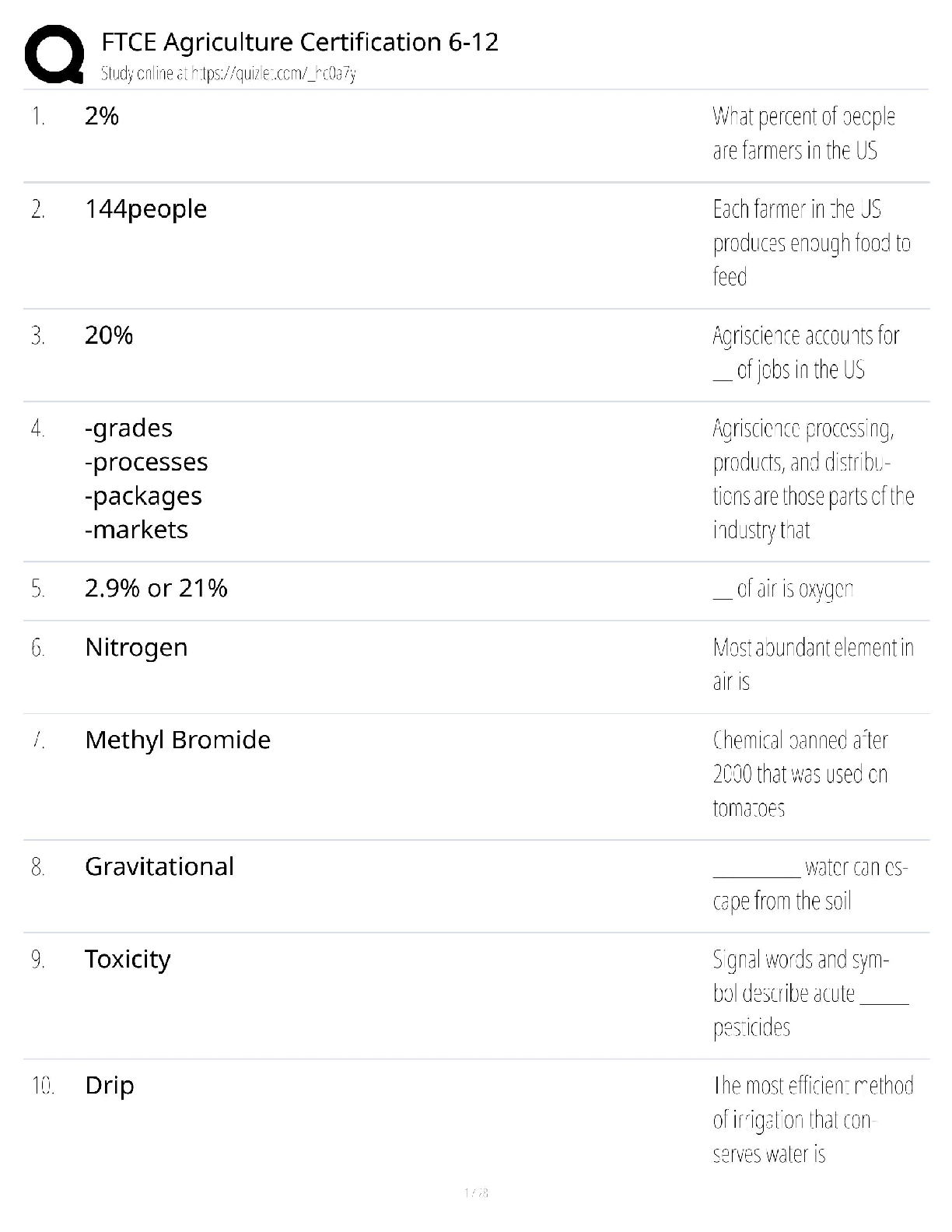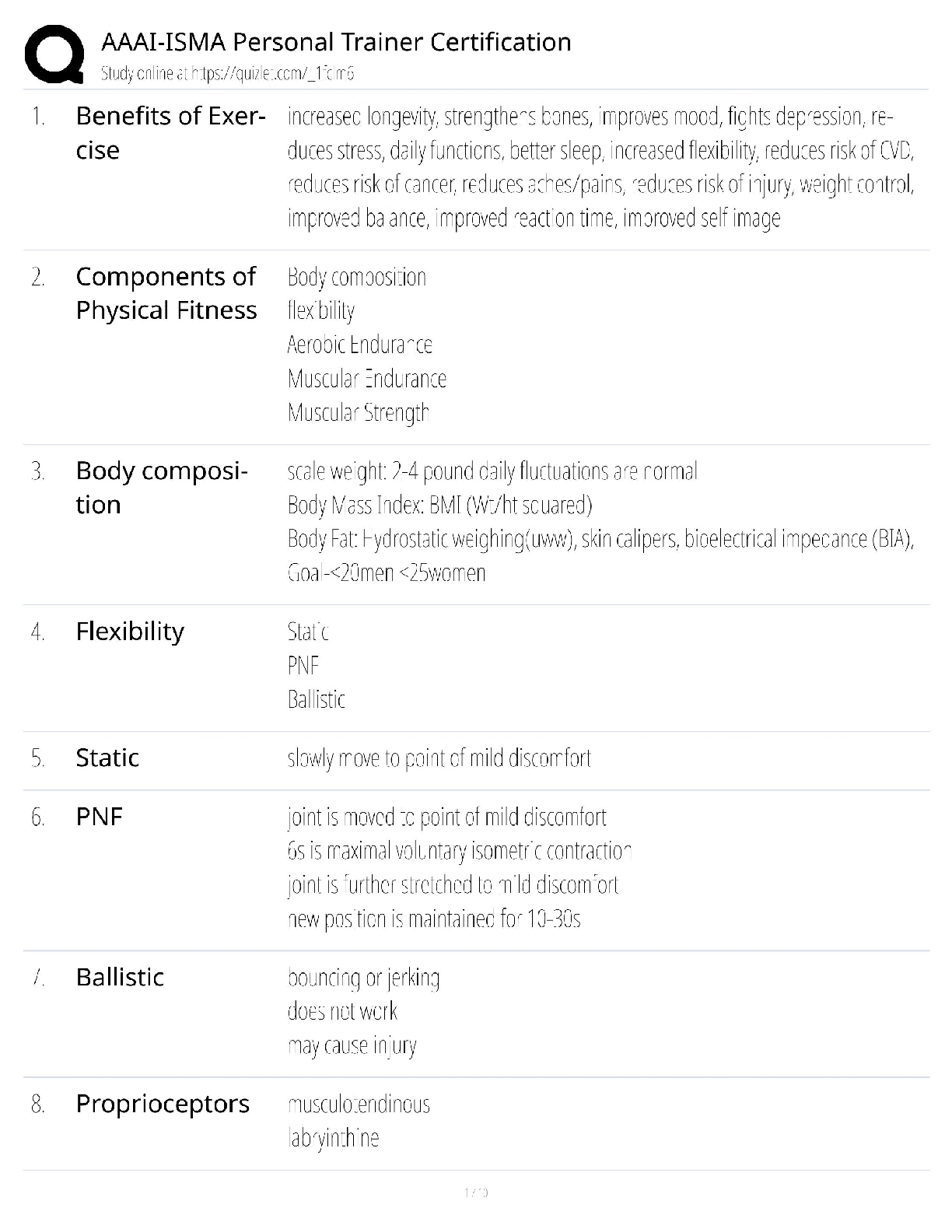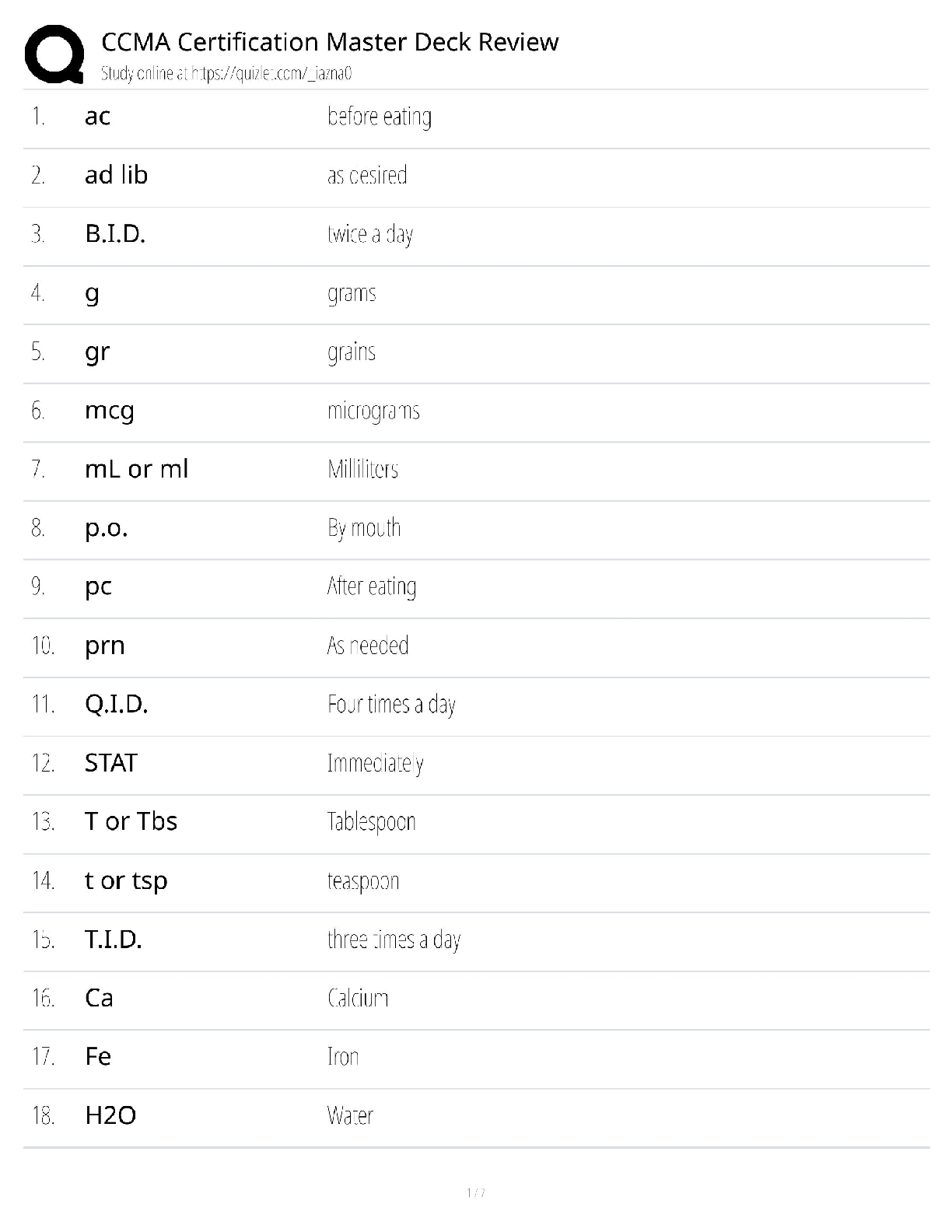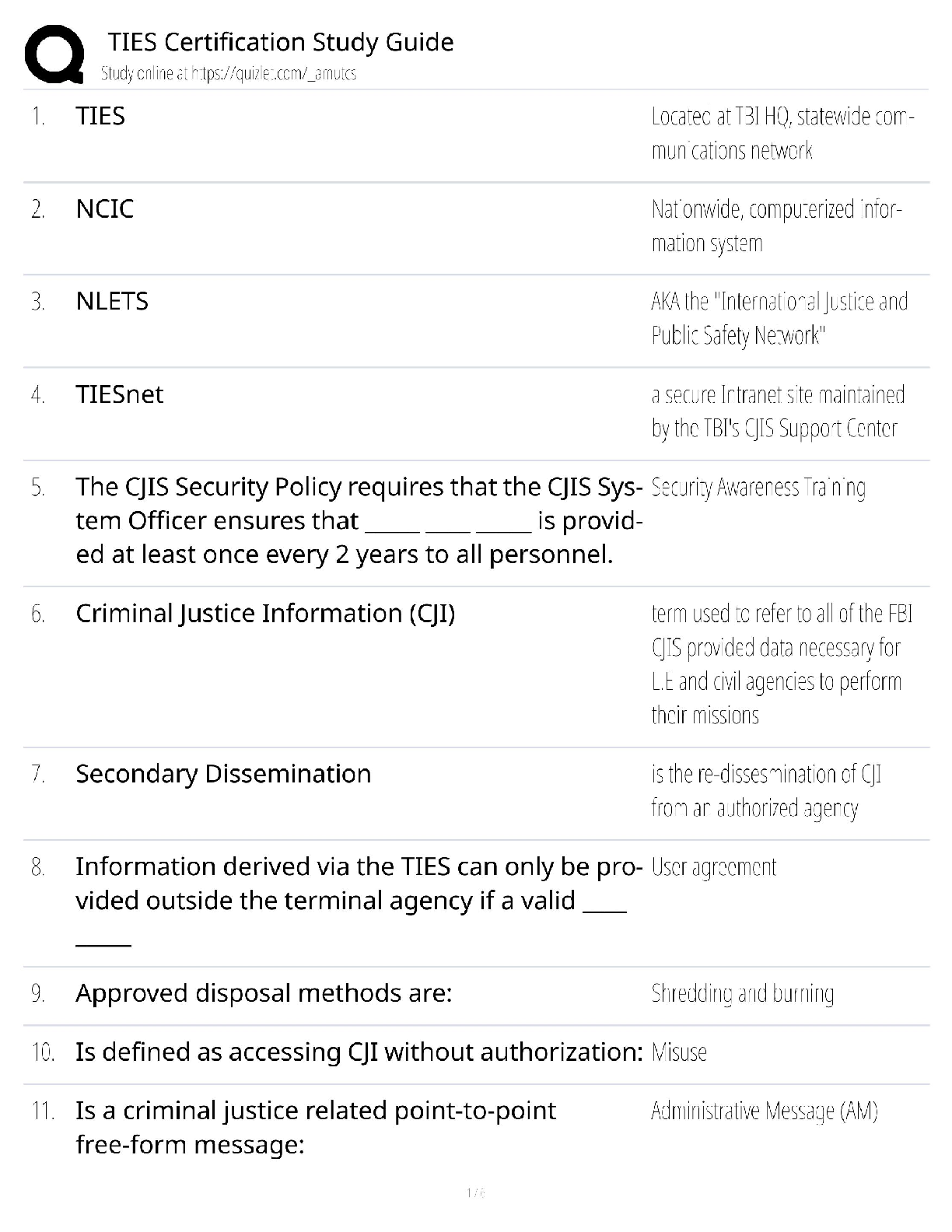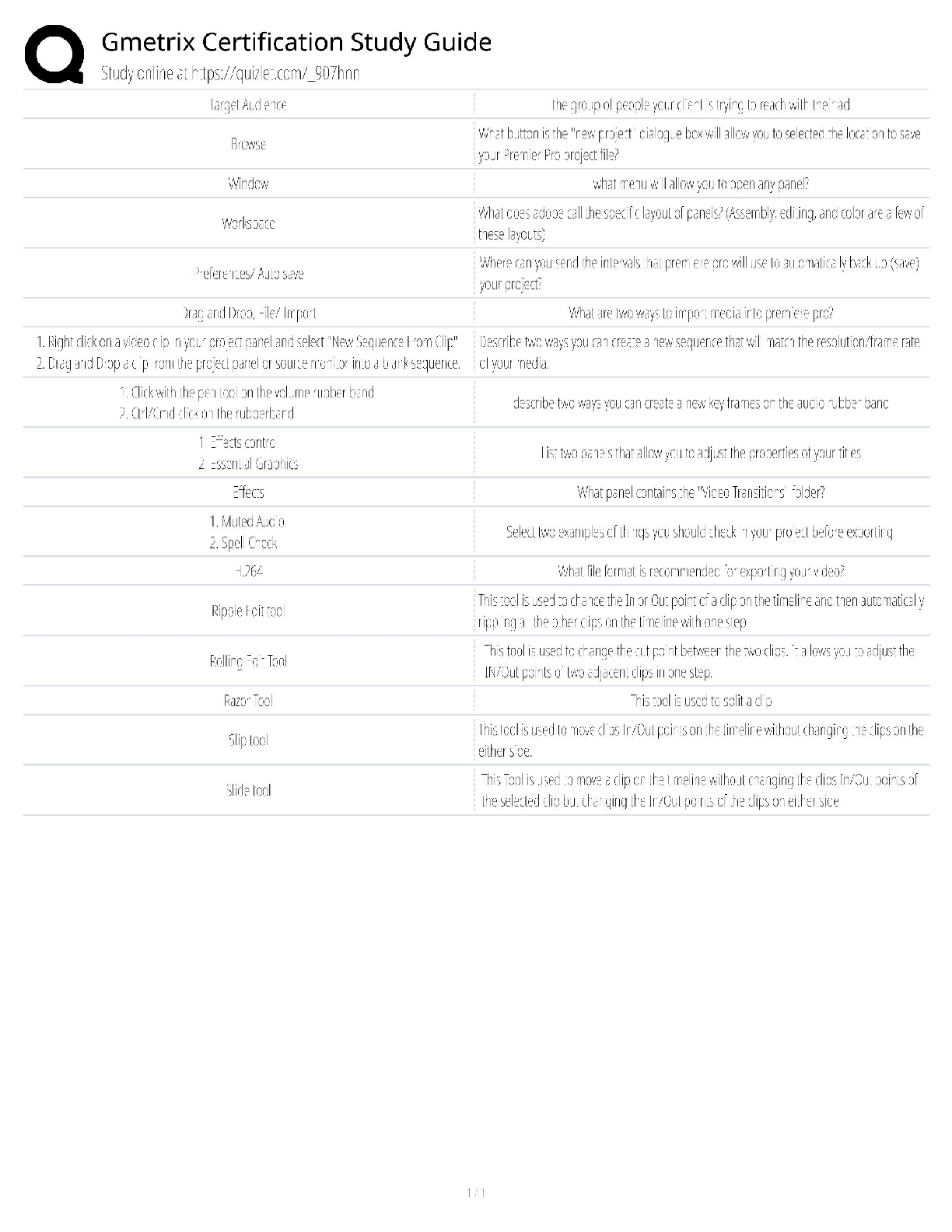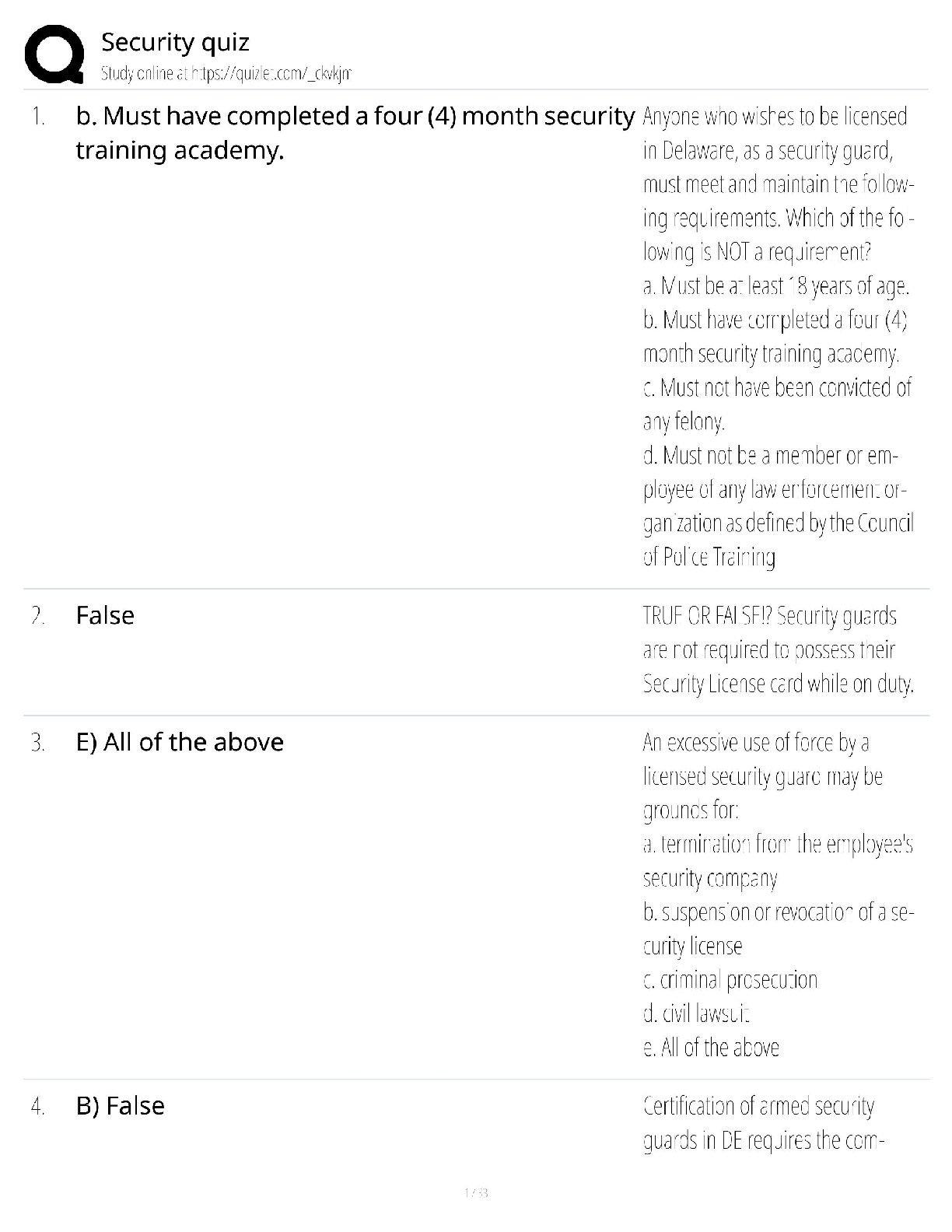Pathophysiology > QUESTIONS and ANSWERS > Discussion Part Two week two nr 507 advanced pathophysiology (All)
Discussion Part Two week two nr 507 advanced pathophysiology
Document Content and Description Below
Discussion Part Two week two nr 507 advanced pathophysiology Discussion Part Two (graded) Tammy is a 33-year-old who presents for evaluation of a cough. She reports that about 3 weeks ago she develo ... ped a “really bad cold” with rhinorrhea. The cold seemed to go away but then she developed a profound, deep, mucus-producing cough. Now, there is no rhinorrhea or rhinitis—the primary problem is the cough. She develops these coughing fits that are prolonged, very deep, and productive of a lot of green sputum. She hasn’t had any fever but does have a scratchy throat. Tammy has tried over-the-counter cough medicines but has not had much relief. The cough keeps her awake at night and sometimes gets so bad that she gags and dry heaves. Write a differential of at least five (5) possible diagnosis’s and explain how each may be a possible answer to the clinical presentation above. Remember, to list the differential in the order of most likely to less likely. Based upon what you have at the top of the differential how would you treat this patient? Suppose now, the patient has a fever of 100.4 and complains of foul smelling mucous and breath. Indeed, she complains of producing cups of mucous some days. She has some trouble breathing on moderate exertion but this is only a minor complaint to her. How does this change your differential and why? Topic responses Discussion Expand All More Sort By: Sarah Drum 9/5/2016 6:11:48 PM Week 2 DB 2 Bronchitis Bronchitis is an inflammation of the lower respiratory track of the bronchial tubes “Acute bronchitis is usually caused by a respiratory virus and occasionally by bacterial infection, although this occurs in less than 10 percent of cases” (Acute Bronchitis, 2016). The symptoms ofbronchitis include coughing up mucus that is yellow or green, a runny or congested nose that started a few days before the chest congestion, fatigue, wheezing, shortness of breath with activities, and “coughing fits.” The patient reports having a runny nose about three weeks ago when this started. A runny nose was her only complaint when the illness started. Once the runny nose went away, the cough and chest congestion started. She currently does not have a fever, but her throat is scratchy. Her throat could be scratchy from all of the coughing she has done. Her symptoms seem to fit all of the symptoms associated with bronchitis, especially since she is not running a fever and the fact bronchitis can last several weeks. The patient is not having any fever or chills, so this could indicate that it is viral, and there is no infection. Pneumonia Pneumonia is a lung infection that can have mild to severe symptoms. They symptoms range from a cough which can produce yellow, green, or bloody mucus, fever, shortness of breath, chills, headache, fatigue, loss of appetite, and sweating. Bronchitis and Pneumonia are very similar, that is why sometimes a person is diagnosed with one when they really have the other. An x-ray can rule out or confirm pneumonia. It can begin with a sore throat, dry cough, muscle aches, and then it will progress to having a productive cough with discolored sputum. It can be from bacteria, viral, or even fungal. The patient is at more of a risk for pneumonia because she did have a cold, it could have possibly turned into a pneumonia due to the congestion (Pneumonia, 2016). Acute Sinusitis “Sinuses are hollow spaces in the bones around the nose that connect to the nose through small, narrow channels” (Sinusitis, 2016). Acute sinusitis is an infection of the sinuses. It affects one in eight adults every year. What happens is the sinus cavities become inflamed and then are unable to empty mucus. The inflammation could have come from the cold, and now that the sinus cavities are blocked from inflammation, she has developed a sinus infection. Symptoms include congestion (chest or nose), pain, pressure, or fullness in the face, and yellow or green mucus. Bacterial sinusitis is suspected if it has been longer than 10 days, and the patient is not better. The patient has had symptoms for at least three weeks, and so acute bacterial sinusitis should be suspected (Sinusitis, 2016). Asthma Even though asthma does not explain all of her symptoms, it is a possibility. The patient may have asthma and an irritant is exacerbating it, which is causing the sputum. These irritants could be pollen, smoke, or house hold chemicals. It also could explain the coughing fits she hasat night, and the shortness of breath with exertion. Symptoms of asthma include tightness in the chest, wheezing, coughing (sometimes with sputum). Sometimes the patient will experience coughing fits, and may occur especially in the morning and at night. She has coughing fits at night. She could have had a case of allergic rhinitis, and not the cold. The allergic rhinitis may have triggered an asthma flare up. The patient would need to find out what is triggering it, and avoid it. Allergic Rhinitis Allergic rhinitis is an inflammation of the nasal membranes such as the nose, eyes, eustachian tubes, middle ear, sinuses, and pharynx that is caused by allergies. The symptoms vary but are sneezing, congestion (chest or nose), headache, red eyes, fatigue, and itchy nose, ear or eyes. Histamine, tryptase, chymase, kinins, and heparin are released in the blood when exposed to an allergen. The release of these into the blood stream gives the patient symptoms that cause inflammation. Once you take the allergen away, the allergic rhinitis goes away. Allergic rhinitis affectes roughly 40 million people in the United States. (Sheikh, J., MD, & Kaliner, M., MD., 2015). She may be allergic to pollen, certain chemicals she has been using lately, or other things such as mold. Based upon what you have at the top of the differential how would you treat this patient? First, I would get a chest x-ray to ensure it is bronchitis and not pneumonia. Then I would prescribe a coughing medication such as Promethazine DM that helps the patient not cough as much, but helps to thin the mucus and get it up when they do cough. This would help with her coughing fits. We want her to cough and get the mucus up, but we do not want her to dry heave and gag due to coughing. I would also give a steroid injection such as Kenalog to help dry her secretions up. The patient can then take over the counter NSAIDS such as Ibuprofen and Tylenol, as well as rest and a lot of fluids. The fluids would also help to thin the mucus, which would make it easier to cough up. Suppose now, the patient has a fever of 100.4 and complains of foul smelling mucous and breath. Indeed, she complains of producing cups of mucous some days. She has some trouble breathing on moderate exertion but this is only a minor complaint to her. How does this change your differential and why? “If it (the cold) hangs around for more than 10 days, or gets worse after it starts to get better, there’s a good chance you have sinusitis” (Sinusitis, 2016). I would then treat the patient for Sinusitis because her sinus cavities have had mucus built up for days and bacteria may bestarting to grow; especially since she has a fever now. One of the symptoms of acute sinusitis is foul smelling breath and mucus, along with fever. (Sinusitis, 2016). Acute Bronchitis, Symptoms, Causes, and Risk Factors. (2016). American lung association. http://www.lung.org/lung-health-and-diseases/lunheg-disease-lookup/acute- bronchitis/symptoms-causes-risk-factors.html. Asthma Symptoms, Causes, and Risk factors. (2016). American lung association. http://www.lung.org/lung-health-and-diseases/lung-disease-lookup/asthma/asthma- symptoms-causes-risk-factors/. Pneumonia. (2016). American lung association. http://www.lung.org/lung-health-and- diseases/lung-disease-lookup/pneumonia/?referrer=https://www.google.com/. Sheikh, J., MD, & Kaliner, M., MD. (2015). Allergic Rhinitis. http://emedicine.medscape.com/article/134825-overview. Sinusitis. (2016). American academy of otolaryngology-head and neck surgery. http://www.entnet.org/content/sinusitis Show Less Janet Farrellyreply to Sarah Drum 9/7/2016 11:27:31 PM RE: Week 2 DB 2 Sarah, Smoking and Tammy's condition: This is a very well written answer as it is easy to follow and it contains a great deal of information! After I introduced myself to Tammy though, I would ask her if she smoked. I am one of six children and only one of my siblings smoke and even though she is not the oldest of us, she looks as though she is. Sometimes my other siblings will say, "Oh, I can't believe that she still smokes", but they don't understand the addictions of smoking and just by telling someone tostop, this isn't going to work! A couple of years ago, I did a report on smoking for a previous class and I was absolutely dumbfounded on the amount of taxes on one pack of cigarettes alone. In the state of New Jersey, for example, the tax on one pack of cigarettes is $2.70 cents, while in the state of NY, the tax, for one pack is over $4.00 dollars! While the "politicians" decided to get together and raise prices on cigarettes, to dissuade individuals from smoking, this is not the solution. If a person wants to smoke, they are going to pay any amount for a pack of cigarettes. The solution is education and, as future nurse practitioners we are here to provide those services! I would teach Tammy, if she did smoke, that there is help out there to stop smoking and she doesn't have to do it alone! For example, if Tammy lived in New Jersey, I would refer her to the New Jersey Quit line at 1-866-NJSTOPS! Reference: Campaign for Tobacco Free Kids. (2016). Map of state cigarette tax rates. https://www.tobaccofreekids.org/research/factsheets/pdf/0222.pdf Show Less Jamie Millerreply to Sarah Drum 9/11/2016 8:27:49 PM RE: Week 2 DB 2 Hello, Sarah. Good post. For this scenario, I had a difficult time trying to decide if Tammy's primary diagnosis was bronchitis or pneumonia. I ultimately choose pneumonia, and it seems I am in the minority. However, I choose pneumonia for certain reasons. First, acute bronchitis caused by a virus does not usually produce a productive cough and bronchitis caused by bacteria is rare in healthy adults (Brashers & Huether, 2013). Viral pneumonia is often caused by a secondary infection, which I believe Tammy started with as the common cold virus (Brashers & Huether, 2013). Community-acquired pneumonia iscommon in otherwise healthy people who do not have contact with the health care environment (Musher & Thorner, 2014). However, the final determination of the primary diagnosis does require an x-ray to confirm. References Brashers, V. L. & Huether, S. E. (2013). Alterations of pulmonary function. In K. L. McCance, S. E. Huether, V. L. Brashers, & N. S. Rote (Ed.), Pathophysiology: The biologic basis for disease in adults and children (7th ed., pp. 1248-1289). St. Louis, MO: Mosby. Musher, D. M. & Thorner, A. R. (2014). Community-acquired pneumonia. The New England Journal of Medicine, 371, 1619-1628. doi: 10.1056/NEJMra1312885 Jamie Miller Show Less Derek McElreathreply to Sarah Drum 9/11/2016 10:27:38 PM RE: Week 2 DB 2 Sarah, Bronchitis seems to fit the picture the best. As you mentioned, bronchitis is an inflammation in the lower respiratory track. The inflammation causes irritation and coughing. I thought your article was interesting that bronchitis is usually causes by viral infections because if that is the case then as you mentioned the 10 percent of causes being bacterial, that means that 90 percent are being mistreated or that antibiotics are being way over prescribed for these infections. "There is the potential for extensive antimicrobial use, some of which might be inappropriate" (Vergidis,Hamer, Meydalni, Dallal & Barlam, 2011). I have seen multiple cases on the recent news about the overprescribing of antibiotics. This overprescribing epidemic does have serious consequences sometimes such as other illnesses like Clostridium difficile associated disease. Its always best to make sure the treatments we offer have benefits that outweigh the risk. Vergidis, P., Hamer, D. H., Meydani, S. N., Dallal, G. E., & Barlam, T. F. (2011). Patterns of antimicrobial use for respiratory tract infections in older residents of long-term care facilities. Journal Of The American Geriatrics Society, 59(6), 1093-1098. doi:10.1111/j.1532-5415.2011.03406.x Show Less Melissa Gushard 9/6/2016 6:10:56 AM Discussion Part Two The first and most likely diagnosis for this patient is that of acute bronchitis. According to Schub (2016) the most common symptom with acute bronchitis is an abrupt onset of a mucous-generating cough. The mucous can vary in color from clear, white, yellow, green, or blood tinged. Other symptoms related to this diagnosis are that of dyspnea, wheezing, fatigue, low grade fever, chest pain/discomfort, sore throat, malaise, myalgia, and post nasal drip. This diagnosis is most likely because it has thecharacteristics of green mucus, chest pain/discomfort may result from the deepness of Tammy's cough, she may have post nasal drip due to her recent cold, and the scratchy throat may be the beginning of a sore throat. Although she doesn't exhibit wheezing, fever, malaise, or myalgia a this time, she may experience these issues if her cough continues to worsen. Chronic cough is another diagnosis for Tammy. McCance, Huether, Brashers, and Rote (2013) summarize that chronic cough is a cough that has lasted for more than three weeks, and can commonly be caused by post nasal drainage, nonasthmatic eosinophilic broncitis, GERD, asthma, or a heightened cough reflex sensitivity (p. 1249). Birring (2011) also report that asthma, GERD, and upper airway disorders often go along with chronic cough, but there is controversy about whether these conditions cause or exacerbate the cough. This diagnosis is likely due to the amount of time the cough has persisted, the fact that the patient may have post nasal drip, and the recent presence of and upper airway disorder. There is no mention about mucus color/amount, or discomfort with the cough listed in the research. Pneumonia is another possible diagnosis for Tammy. Thompson (2016) states that the symptoms for this diagnosis include a cough with phlegm, difficulty breathing, chest pain, fatigue, and confusion. Tammy presents with a cough with phlegm, and she may have chest pain due to the deepness and frequency of the cough. Although Tammy doesn't show many of the symptoms of pneumonia, it may be in the early stages and she may not have all the symptoms at this point. Chronic Obstructive Pulmonary Disorder (COPD) is another diagnosis that could possibly be used for Tammy's symptoms. Holmes and Murdoch (2016) summarize that COPD is usually associated with cigarette smoking, and presents with breathlesness on exertion, cough at times, and a change in sputum color. A thorough history will need to be taken to identify risk factors such as smoking to make a diagnosis of COPD. Tammy has the symptoms of coughing and green sputum color, but lacks the other symptoms of COPD at this time. Another diagnosis possible for Tammy is that of lung cancer. McCance, Huether, Brashers, and Rote (2013) state that early stage symptoms can include coughing, chest pain, excessive sputum production, pneumonia, airway obstructions, hemoptysis, plueral effusions, and weight loss. These symptoms are often reported as attributions to smoking. Although this diagnosis is least likely, if there is no other plausible reason, lung cancer should be ruled out. Tammy exhibits the coughing, excessive sputum production, likely airway obstruction due to coughing fits, gagging, and dry heaves, and chest pain could be attributed to the deepness of the cough. It isimportant to see if this patient smokes or has a history of smoking to help with this diagnosis (p. 1282). Schub (2016) summarizes that treatment for acute bronchitis includes promoting optimal physiologic status and reducing complications. Compling an assessment and vital signs, and prescribing medications PRN are also part of the treatment plan. Antivirals may be prescribed if the patient is suspected to have the flu, and antibiotics may be prescribed if the cause is presumed to be bacterial. The patient will also be educated about the importance of rest, hydration, nutrition, and monitoring for worsening symptoms. When Tammy reports with worsening symptoms, I would change her diagnosis to pneumonia. According to the symptoms I mentioned previously, Tammy now exhibits difficulty breathing and fever. Thompson (2016) states that bacteria are the most common causes of pneumonia in adults, and this could be causing the foul smelling mucous and breath. References Birring, S. (2011). Controversies in the evaluation and management of chronic cough. American Journal of Respiratory and Critical Care Medicine. 183 (6). 708- 715. doi: 10.1164/rccm.201007-1017CI Holmes, S., & Murdoch, C. (2016). Advances in COPD: a glimpse of the future. Practice Nurse. 46(4). 1-8. Retrieved from http://eds.b.ebscohost.com.proxy.chamberlain.edu:8080/eds/detail/detail? sid=73ba6714-6b54-453b-9e0f- 22aab679441a %40sessionmgr120&vid=2&hid=117&bdata=JnNpdGU9ZWRzLWxpdmU %3d#AN=114619818&db=a9h McCance, K.L., Huether, S.E., Brashers, V.L., & Rote, N.S. (2013). Pathophysiology: The biologic basis for disease in adults and children (7th ed). St. Louis, MO: Mosby Schub, T. (2016). Bronchitis, acute. CINHL Nursing Guide. Retrievedfrom http://eds.a.ebscohost.com.proxy.chamberlain.edu:8080/eds/pdfviewer/pd fviewer? vid=2&sid=ea4a0237-f859-4513-aa15- ff2521606286%40sessionmgr4010&hid=4108 Thompson, A. (2016). Pneumonia. The Journal of the American Medical Association. 315(6). 626. Retrieved from http://eds.b.ebscohost.com.proxy.chamberlain.edu:8080/eds/pdfviewer/pdfviewer? vid=2&sid=deaa2442-42cc-4105-9586- 2e6e17697222%40sessionmgr106&hid=117 Show Less Sarah Drumreply to Melissa Gushard 9/9/2016 12:08:30 PM RE: Discussion Part Two You do have a good plan, but it would be nice to see more specifics of how you would treat the patient. I too agree that the patient has bronchitis, but I would treat it differently. According to the National Heart, Lung, and Blood Institute, I would first get a chest x-ray to cross out pneumonia (How is Pneumonia, 2016). You state if she does not get any better you would then get an x-ray to rule out pneumonia. Instead of her possibly having to make two trips to the office, we could get an x-ray and limit to this one visit. Also, you state antivirals can be prescribed if it is thought she has the flu. The flu could be ruled out by doing a rapid flu test. Then she would not have to have more medication. I worked at a physician’s office when I was an LPN and I saw cases like this all of the time. Most of the time an antibiotic is not needed for bronchitis. “Acute bronchitis is usually caused by a respiratory virus and occasionally by bacterial infection, although this occurs in less than 10 percent of cases” (Acute Bronchitis, 2016). Since most cases are caused by a virus, I would treat with medication, rest, fluids, and NSAIDS like you said. The medication I wouldgive is Promethazine DM because it helps to thin the mucus and calm coughing fits, but it does not stop the coughing. We do not want to give anything with codeine in it because that would make her stop coughing, and we want her to continue to cough. We want the patient to cough up the mucus in the lungs. I would then give her a steroid injection if she does not have diabetes because steroids would help to dry the mucus out. If she has diabetes I do not think I would give that because that would make her sugar levels go up more. I would then recommend lots of rest and fluids along with Ibuprofen or Tylenol if needed. Acute Bronchitis, Symptoms, Causes, and Risk Factors. (2016). American lung association. http://www.lung.org/lung-health-and-diseases/lunheg-disease-lookup/acute- bronchitis/symptoms-causes-risk-factors.html. How is Pneumonia Diagnosed? (2016). National heart, lung, and blood institute. http://www.nhlbi.nih.gov/health/health-topics/topics/pnu/diagnosis. Show Less Instructor Brownreply to Melissa Gushard 9/9/2016 9:58:15 PM RE: Discussion Part Two Melissa, Explain the importance of hydration? How much fluid I lost with fever? Excessive respiration. Show Less Melissa Gushardreply to Instructor Brown 9/10/2016 3:09:46 AM RE: Discussion Part Two Dr. Brown, Although hydration is important for general health, hydration is critical for the body'stemperature control and to replenish fluid lost from sweating (Popkin, D'Anci, & Rosenberg, 2010). Hydration from excessive sweating results in a loss of electrolytes, reduction in plasma volume, and may lead to increased plasma osmolarity (Popkin, D'Anci, & Rosenberg, 2010). Fluid loss via skin can range from 0.3 L/h in sedentary conditions to 2.0 L/h with increased temperature and high activity (Popkin, D'Anci, & Rosenberg, 2010). According to Jequier and Constant (2010) normal water loss by evaporation through the respiratory tract is 250-350 ml/day. Excessive respirations would increase this amount, and would also need to be replenished through hydration. Melissa References Jequier, E., & Constant, F. (2010). Water as an essential nutrient: the physiological basis of hydration. European Journal of Clinical Nutrition. 64. 115-123. doi: 10.1038/ejcn.2009.111 Popkin, B., D'Anci, K., & Rosenberg, I. (2010). Water, hydration and health. Nutrition Reviews. 68(8). 439-458. doi: 10.1111/j.1753-4887.2010.00304.xShow Less Loretta Karpinskireply to Melissa Gushard 9/12/2016 1:00:11 AM RE: Discussion Part Two Melissa, Thank you for sharing the information on the chronic cough. My father is a liver transplant patient and for the last few years he has had this terrible dry cough. I finally brought it up toShow More Mijanou Marretta-Lewis 9/6/2016 1:59:27 PM Discussion Two Week Two heaves. Dr. Brown and Classmates, Respiratory diseases can be difficult to diagnose. Many of the general symptoms from respiratory diagnoses can overlap symptoms and mirror more serious conditions (McCance , Heuther, Brashers,& Rote,2013). Symptoms such as cough, with or with productivity of sputum, fever, chills, lethargy and general malaise are common complaints (Goroll &Mulley, 2014). In this scenario Tammy had been suffering from a cold like symptoms for the past three weeks. The need to obtain a complete health history would also include whether she is a smoker, what over the counter medications were working and what was not, history of seasonal allergies, environmental allergies and is she on an angiotensin-converting-enzyme (ACE) inhibitor, which has been associated with dry nocturnal coughing, with a higher incident among women than men (Goroll &Mulley, 2014). She has a productive purulent cough so the ACE inhibitor if she is on one may not be the cause to her issue. Differential Diagnoses: 1. Acute Bronchitis is an infection of the large airways that is self-limiting and characterized by a cough. The bronchi are swollen and irritated and causes damageto the cilia and epithelial cells of the respiratory tract. It can be cause by viral or bacterial infection processes. Symptoms include: cough with or without sputum, sore throat,low grade fever, post nasal drip and fatigue with body aches. In many incidents if the cough is longer than several days, bronchitis would be a likely diagnosis. The possibility of a viral upper respiratory infection can also mirror the symptoms and signs of bronchitis. Although Tammy states her symptoms of her cold had dissipated, a cough can continue for several weeks. In this case the patient has complained of upper respiratory issues at the onset of the cough with purulent drainage which leads to a strong possibility of acute bronchitis (File, 2016). Treatment for this primary differential diagnosis. The need for a chest x=ray, with a follow up to four to six weeks is needed to see if patient has gone back to base line (Gorollo & Mulley, 2014). If the chest x-ray is abnormal the need for a computerized tomography (CAT) scan may reveal a more definitive diagnosis. A sputum culture should be obtained to isolate the infection and to rule out any organism. If there is a bacterial infection then the use an antibiotic would be necessary with a narcotic cough suppressant, expectorant, possible steroid use with a sliding scale, decongestant; possible antihistamine could help to alleviate these symptoms (Gonzales, Anderer, McCulloch, Maselli, Bloom et al., 2013). Gargling with hot salt water can help with the sore throat and clean the throat of any residual mucous. 2. Pneumonia is an infection of the lungs. It is possible this patient has developed a secondary infection from the post nasal drip that has caused an opportunistic bacterial infection to take place, or has been exposed to community-acquired pneumonia, which is a non-bacteremic pneumonia. Since we have no history of this patient, we do not know if she is immunocompromised. The pathophysiology of pneumonia includes the respiratory tract, bronchi and bronchioles that affect the alveoli. The alveoli have a thin membrane that that is surrounded by capillaries. These little sacs are exposed to what we breath in on a daily bases and usually can ward off any organism that comes into contact. However with a compromised lung system the immune system is weakened and opportunist bacterial can enter causing an infection process, which includes purulent drainage, fever, chill, cough, lethargy and malaise (File, 2016). As the inflammation process begins the alveoli that have become infected fill to white blood cells, red blood cells and protein and the production of purulent sputum and fever begins (Said, Johnson, Nonyane, D-Knoll, O’Brien,2013)). In the case of this patient had it not been fever, this would have been a second differential diagnosis. Obtaining x-rays would rule out this condition with possible CBC with a differential to check the levels of WBCs which would indicate infection. This would follow with the possibility of antibiotics, antihistamines, inhalers, antipyretic medications, expectorants as mentions in the previous differential diagnosis. 3. Sinusitis is a potential diagnosis as acute sinusitis is considered the second most common infecting seen in the primary care setting which can be caused by the common cold (Goroll & Mulley, 2014). Acute sinusitis is seen from a blockage of the sinuses, which result in infected and stagnant drainage. The post nasal drip that accompanies Tammy’s night time coughing could result from this however, she si not complaining of headaches or sinus pressure, as there is no paranasal tenderness which is a common feature of this disease process (Venekamp et al., 2011). This disease may also not qualify as she has a purulent cough with copious amounts of green secretions. 4. Lung Cancer-adenocarcinoma, is an unlikely diagnosis, however the productive and persistent cough does fit that piece of the profile. A constant and persistent cough is not uncommon in the early stages of lung cancer. Lung cancer appears in the early stages as coughing, chest pain, and excessive sputum secretions. The diagnoses of early stages of lung cancer are difficult as the manifestation is seen after approximately eight months (Vansteenkiste et al., 2013). Many times cancer of the lung is caught by accident early as a patient may have required a chest x-ray for other reasons (Vansteenkiste et al., 2013). At this time with no apparent history of the patient with smoking or being a second hand inhaler, this is a less likely diagnosis. 5. Asthma is a seen as a symptom of wheezing, shortness of breath, gasping for air, chest tightness and cough. Allergens such as animal dander, pollens, and exercises as examples of triggered immune responses (Burns, 2012). However, the diagnosis does not fit well as asthma does not produce large amounts of green sputum. If the patient was running a fever of 100.4 and complains of foul smelling mucous and breath and producing cups of mucous some day with moderate exertion of breathing, how would this change your differential and why? In this case the differential would be changed to a possible other pathogen in her system. Potential bronchiectasis or pneumonia would be the primary diagnosis. It would be necessary toact more quickly as shortness of breath can be a life threatening situation with a potential of her having mycoplasma pneumonia which can be fatal. The need for x-rays, sputum cultures, potential CAT scan and possibly pulmonary functions study as well as CBC with a differential and a basic metabolic panel would be in order, as well as the above mentioned interventions. The change of differential would result from the increase in symptoms that were common to more serious and potentially life threatening. To rule out pneumonia, which would become primary diagnosis we would need to follow evidence-based guidelines and act quickly before the patient has an exacerbation of symptoms. Mijanou References Burns, D. (2012). Management of patients with asthma and allergic rhinitis. Nursing Standard, 26(32), 41-46. doi:10.7748/ns2012.04.26.32.41.c9045 Dempsey, P. P., Businger, A. C., Whaley, L. E., Gagne, J. J., & Linder, J. A. (2014). Primary care clinicians’ perceptions about antibiotic prescribing for acute bronchitis: a qualitative study. BMC family practice, 15(1), 1.doi:10.1186/s12875-014-0194-5 File, T. M. (2016). Acute bronchitis in adults. In T. W. Post (Ed.), UpToDate. Retrieved from http://www.uptodate.com/contents/acute-bronchitis-inadults-beyond-the-basics. Gonzales, R., Anderer, T., McCulloch, C. E., Maselli, J. H., Bloom, F. J., Graf, T. R., ... & Metlay, J. P. (2013). A cluster randomized trial of decision support strategies for reducing antibiotic use in acute bronchitis. JAMA internal medicine, 173(4), 267-273. doi:10.1001/jamainternmed.2013.1589 Goroll, A. H., & Mulley, A. G. (2014). Primary care medicine: Office evaluation and management of the adult patient (7th ed.). China: Wolters Kluwer. McCance, K. L., Huether, S. E., Brashers, V. L., & Rote, N. S. (2013). Pathophysiology: The biologic basis for disease in adults and children (7th ed.). St. Louis, MO: Mosby. Said, M. A., Johnson, H. L., Nonyane, B. A., Deloria-Knoll, M., Katherine, L. O., & AGEDD Adult Pneumococcal Burden Study Team. (2013). Estimating the burden of pneumococcal pneumonia among adults: a systematic review and meta-analysis of diagnostic techniques. PloS One, 8(4), e60273. doi:10.1371/journal.pone.0060273Vansteenkiste, J., De Ruysscher, D., Eberhardt, W. E. E., Lim, E., Senan, S., Felip, E., & Peters, S. (2013). Early and locally advanced non-small-cell lung cancer (NSCLC): ESMO Clinical Practice Guidelines for diagnosis, treatment and follow-up. Annals of oncology, mdt241. Doi: 10.1093/annonc/mdt241 Venekamp, R. P., Thompson, M. J., Hayward, G., Heneghan, C. J., Del Mar, C. B., Perera, R., ... & Rovers, M. M. (2011). Systemic corticosteroids for acute sinusitis. The Cochrane Library. doi:10.1002/14651858.CD008115.pub2. Show Less Nadalia Kargenian 9/7/2016 2:35:14 PM Discussion part two Class, Possible differential diagnoses for this patient are: - Acute bronchitis: Based on the signs and symptoms provided the patient may have developed bronchitis which would explain the deep productive cough. Common signs of bronchitis, specifically bacterial bronchitis include productive cough, fever, pain behind the sternum that is worsening with the cough (McCance & Huether, 2014). The initial presentation does not include the fever which could mean this is more viral or just that it has not progressed to this point yet. The symptom of rhinorrhea does not fit with the diagnosis of bronchitis but may have been an upper respiratory infection that preceded the lower infection (McCance & Huether, 2014). - Viral infection/common cold: There is no mention of any significant medical history or immune deficiencies so this could be a general head cold that has moved into her chest or lower respiratory tract. No fever is present which could indicate more of a viral cause, but there is a productive cough with green colored sputum which typically can indicate bacterial infection. The scratchy throat could be an effect from post nasal drip or her previous rhinorrhea in the past few weeks. - Pneumonia: The patient’s symptoms could also be consistent with pneumonia though additional diagnostic testing would be needed (chest x-ray and physical exam with auscultation and percussion to the chest to confirm consolidations etc.). Symptoms consistent with pneumonia arethat the cough is preceded by an upper respiratory infection which leads to the onset of a cough that is often productive (McCance & Huether, 2014). Since over the counter medication has not helped her symptoms, this could indicate the cause is bacterial and an antibiotic is needed. - Bronchiectasis: Bronchiectasis as a diagnosis for this patient would require additional information and testing however the lack of response to over the counter treatment and moderate to severe productive cough could lead to this differential. Typically the primary symptom of this disease is a chronic productive cough (which would be more than 3 weeks) and foul-smelling sputum (McCance & Huether, 2014). Lack of fever would also be consistent with bronchiectasis (McCance & Huether, 2014). This may not be a diagnosis at this time since her cough has only been going on for 3 weeks or so from the information gathered so far. - Tuberculosis (TB): TB is often clinically shown by fatigue, weight loss, anorexia, and a low- grade fever. At this time the patient does not fit that profile. She does however have a productive cough that developed over a few weeks after her initial cold symptoms, which is consistent with TB (McCance & Huether, 2014). It is not known what type of occupation or exposure risks the patient would have had to contract this highly contagious airborne droplet transmitted infection but it is possible (McCance & Huether, 2014). If the patient did in fact have acute bronchitis, no antibiotic therapy would be recommended as most acute infections are of viral origin in generally healthy patients (Goroll & Mulley, 2014). The patient could be advised to continue with symptom management with over the counter treatments of cough medicine, especially suppressants at night to ensure she can gain a good night’s sleep to aid in recovery (Goroll & Mulley, 2014). If additional signs or testing indicated bacterial bronchitis or if she more likely had pneumonia then antibiotics would be recommended as they are the cornerstone of initial treatment (Goroll & Mulley, 2014). For pneumonia, the patient could be prescribed erythromycin which covers most types of pneumonia in health young adults (Goroll & Mulley, 2014). Additional recommendation could also be with inhaled corticosteroids if the cough progresses and/or if chest pain and dyspnea develop (McCance & Huether, 2014). If the patient developed even more of a productive cough that now has a foul odor this would indicate a higher likelihood this could be bronchiectasis. One of the cardinal signs of this disease is excessive amounts of foul-smelling purulent sputum that can be measured in cups (McCance & Huether, 2014). Since she was initially not taking any antibiotics just over the counter treatments this foul smell development over time is consistent with bronchiectasis. This would likely move this disease up to the top of the list with pneumonia and bronchitis.Another possibility would be a disease like Williams-Campbell Syndrome (WCS) with is a rare congenital disease of the lower respiratory tract (bronchial anatomy) that leads to the development of bronchiectasis (Noriega, Adrian, & Saliski, 2014). This disorder is usually seen in children who present with recurrent pneumonia and bronchial symptoms but also reported in adults usually from a previous misdiagnosis in childhood (Noriega et al., 2014). Diagnosis of this could be made based on symptoms, history of previous recurrent lower respiratory infections as well as radiology confirmation and exclusion of other causes (Noriega et al., 2014). Treatment of this disorder can include breathing exercises, prolonged courses of antibiotics, inhaled corticosteroids, or other pharmacologic’s like beta 2 agonists or anticholinergics (Noriega et al., 2014). References Goroll, A.H., & Mulley, A.G. (2014). Primary care medicine: Office evaluation and management of the adult patient. (7 th ed [Show More]
Last updated: 3 years ago
Preview 1 out of 73 pages
.png)
Buy this document to get the full access instantly
Instant Download Access after purchase
Buy NowInstant download
We Accept:

Reviews( 0 )
$16.00
Can't find what you want? Try our AI powered Search
Document information
Connected school, study & course
About the document
Uploaded On
Sep 08, 2021
Number of pages
73
Written in
All
Additional information
This document has been written for:
Uploaded
Sep 08, 2021
Downloads
0
Views
147

.png)
.png)
.png)
.png)
.png)
.png)
.png)
.png)
.png)
.png)
.png)
.png)
